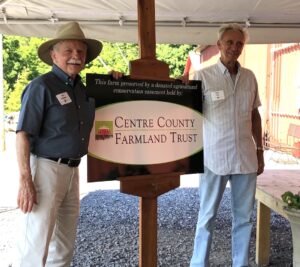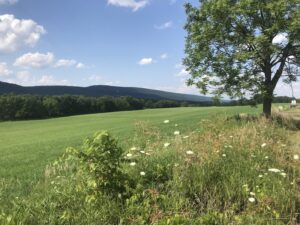Love of their land is often what prompts landowners to establish a conservation easement with a land trust like the Centre County Farmland Trust.
Conservation easements are tailored to a landowner’s unique goals and objectives — and the land’s natural resources. Once their land is preserved, landowners often have a greater peace of mind about the future of their land.
Exploring the preservation process begins with a conversation. Please use the form below to contact the Farmland Trust. A volunteer Trustee will be in touch to answer your questions.
The preservation process requires many considerations and often takes about a year.
Read on for an overview of preservation for landowners.
What is farmland and land preservation?

Private landowners who wish to preserve their farmland, woodlot or otherwise open, undeveloped land can work with the Centre County Farmland Trust to achieve their goals by placing a legally binding conservation easement on their land.
The Centre County Farmland Trust is a farmland-focused land trust. Our mission is to preserve and protect farmland and open land in Central Pennsylvania. Learn more about the Trust.
Here in Central Pennsylvania, we are losing the farmland and open land that is vital to our quality of life. To read more about this problem, visit Why Preserve Farmland.
How does a conservation easement work?
A conservation easement codifies the agreement between the landowner and CCFT regarding the preserved property.
This legal document is attached to the property deed for current and future owners. The easement documents a property’s conservation values with associated goals and actions necessary to maintain or enhance those values. An easement binds a landowner and a qualified organization, like CCFT, to protect the natural, cultural, and/or historic resources of a property perpetually by permanently restricting uses of the land for purposes not consistent with agriculture or conservation.
An easement specifies the donating landowners’ objectives for protecting a property. Specific land uses might be protected, depending on the owner’s wishes. Examples include crop fields, pastures, other open spaces; riparian areas along waterways, woods and orchards.
No two easements are exactly alike. Every easement refers to a particular property’s characteristics and the donating owner’s goals. Learn more about conservation easements.
What is the first step?
A conversation. Please use the contact form above. A volunteer Trustee will get in touch to answer questions and help you explore land preservation.
What is the process for establishing an easement?
After expressing their interest in preservation, a landowner and a volunteer Trustee from CCFT have initial conversations to explore their goals and the easement process. Landowners are encouraged to consult an accountant for tax implications as well as having a personal attorney.
One of the initial considerations is to determine the best partner organization. We work with several land preservation entities toward a common goal of land preservation. Their names and details are listed below.
If the landowner and CCFT proceed, they become partners in establishing the easement, then in upholding it into the future. The landowner and CCFT summarize the property’s conservation values and natural resources, along with characteristics and the current condition of areas to be protected, in a baseline documentation report.
This deliberative process often takes at least a year. Then, the Centre County Farmland Trust holds, stewards and — if necessary — enforces the easement into the future, working with current and future landowners as the property changes hands. Learn more about our stewardship program.
The Trust does not compensate landowners for their development rights.
Is CCFT the only organization that can preserve my land?
No. There are several options.

It’s important for landowners to explore their options to find the best partner in preserving their land and to be comfortable with that organization.
In Central Pennsylvania, landowners can work with the organizations below to preserve their land: The Centre County Farmland Trust works with all of these organizations toward our common goal of preserving land.
- ClearWater Conservancy, which helps protect drinking water, watersheds and ecologically important land such as mountain ridges. For example, CWC is working to use preserved lands to connect Rothrock Ridge to the Bald Eagle Ridge for wildlife and public recreation. CWC is also working to influence land use planning and zoning ordinances to limit development on ridges. (Visit ClearWater Conservancy’s Land Conservation program.)
- The Western Pennsylvania Conservancy, in Pittsburgh, preserves land in Central Pennsylvania and is our partner on the Stover easement preserving 189 acres in Haines Township.
- Centre County’s Purchase of Agricultural Conservation Easement PACE program — part of a statewide farmland preservation program — scores and ranks applicant farms based on soil quality, development pressure, productivity and proximity to other preserved land. PACE purchases agricultural conservation easements, meaning landowners can be compensated for their development rights.
Agricultural Land Preservation in Pennsylvania
Pennsylvania leads the nation in preserving farmland with more than 6,400 farms approved for easement purchase, totalling more than 645,000 acres statewide. Read the latest about the commonwealth’s agricultural land preservation here.
In Pennsylvania, 58 counties have agricultural land preservation boards that purchase agricultural conservation easements, like Centre County’s PACE program. There are also 68 private charitable land trusts that accept donations of conservation easements.
The Centre County Farmland Trust follows the land trust model. CCFT’s co-founders served on Centre County’s agricultural land preservation board and spotted a need for a private land trust, which led to the founding of the Centre County Farmland Trust in 1994. Read about our history.
Here is a guide to preserving your farmland through PACE: A Guide to Preserving Farmland through the Centre County Purchase of Agricultural Conservation Easement (PACE) Program.
Questions? Please use the form at the top of this page to contact CCFT and schedule a conversation with one of our volunteer Trustees to learn more about preserving your land.